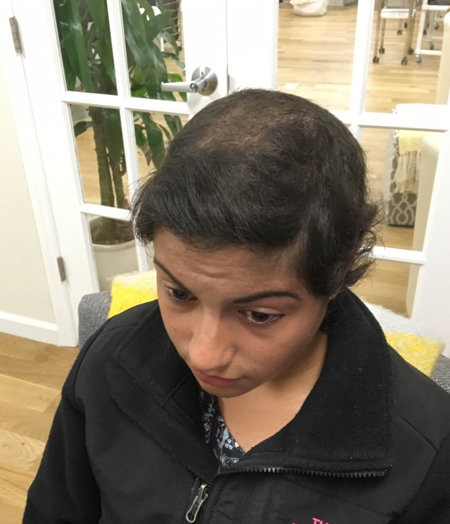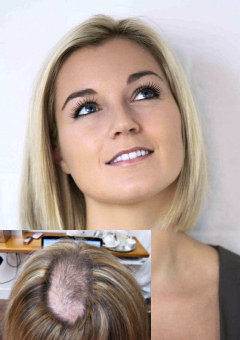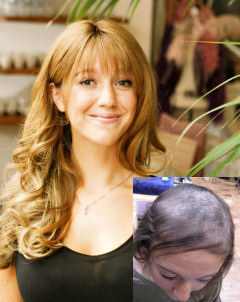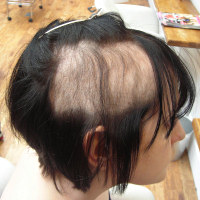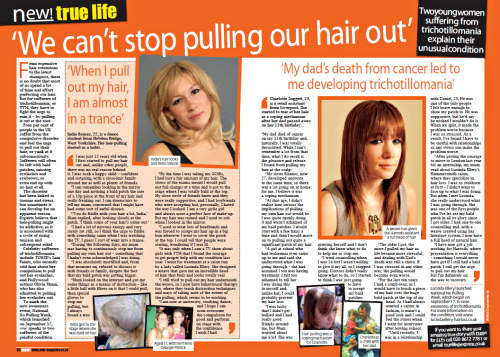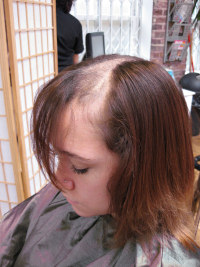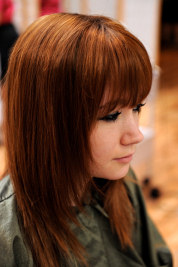How Lucinda Ellery has helped me overcome a lifetime of hair-pulling.
By Anna Bruning
The day, 20 years ago, I decided to finally request a meeting to discuss my hair loss at the Lucinda Ellery Consultancy ranks among one of the most important in my life.
It had taken me years to get up the courage to make that call to ask for the help with my hair I desperately needed – and to override that little voice within that told me no one and nothing would be able to undo the lifetime’s damage I had done to my follicles. And that I didn’t deserve it. So there!
I had been living with the secretive and ruinous desire to pull out my own hair since the age of 13. I craved that rush of serotonin release in response to a childhood of beatings, vicious putdowns and bullying both at home and in school. But of course the pulling that gives relief from emotional pain also creates it anew, with each fresh cycle of destruction. After all, hair is literally a woman’s crowning glory and there I was, turning mine into a patchy, scraggy mess. Desirable me just when I should be dating? Not exactly.
It is impossible to say what hurt more, the pulling or the realisation that I had just freshly re-sabotaged my brave, struggling follicles under constant attack.
Each time something upset me – and, like for most of us, things do, almost daily – my busy little fingers went cotton-picking straight up into my roots for that sharp nerve twinge, followed by sweet release.
By the time I made that call to the Lucinda Ellery Consultancy there was very little hair left on my head. It had become impossible to hide the large bald patches, even behind the permanent up-do that was my calling card. My partner said he loved me, but I didn’t love myself.
My hair issues hurt my confidence – and my career
My hair story definitely hurt my professional life. Rival colleagues sensed my secret vulnerability. People used to sneak up behind my desk and try to swiftly undo my hairclips.
“Go on, Anna, let your hair down,” was the bullying ‘joke’, fully aware that something was stopping me. For my birthday one year my office designed a collage card featuring my face topped with allegedly witty hairstyles – from Marie Antoinette-like tall-ship wigs to punk Mohicans, from Jennifer Aniston’s iconic ‘Rachel’ style to cornrows, an Afro, dreadlocks and more. Very amusing. Not. Needless to say, it all added to me feeling super unconfident. I never even considered putting my naked head above the parapet for promotion.
Now, after 30 years of unstoppable self-harm – giving in to the overwhelming craving for warm release after the pain of pulling, then knowing I had yet again destroyed weeks’ or months’ worth of hopeful regrowth – I was on the cusp of transformation.
Nervous ahead of the first consultation
I was shaking when I drove to meet the Lucinda Ellery team for the first time, unsure they could help me. Jumpy, I scraped the entire length of my brand new Mercedes. The car proved more expensive to fix than my hair has ever been!
The minute I was buzzed into the Consultancy all that fear dropped away. The salon is gorgeous: a bright, beautiful, safe, warm and welcoming space. I was greeted with genuine care. No one was judging. Everyone was there to help. Privacy and discretion guaranteed.
Best of all, I was told with sincerity and warmth that mine was not the worst case Lucinda Ellery had seen. In fact, I had plenty of natural hair on my head for them to work with.
I also heard for the first time that hair-pulling is surprisingly common. I had researched my condition and had come across the term Trichotillomania. Have to say, still not thrilled with the ‘mania’ element of the term that is cobbled together from various Greek medical words. And I had no idea how many women might suffer from this destructive impulse. I was pretty sure I was the only one. Back in the day, that sort of information simply wasn’t out there.
The salon had the reassurance. Although just under 2% of us worldwide have the condition, more commonly known as TTM, they explained that it is more prevalent among females. You just feel alone because we don’t exactly see TTM women power-posing their way across the planet, gleaming scalps signalling our sexual allure and feminine mojo. And I wasn’t mad. I was merely one of those (mainly starting in childhood, in response to events we cannot control) who find release in hurting their own largest and nearest vital organ, their skin – by worrying at it and its variations. Girls and boys skin-pick, nail-bite, hair-pull, cut, ink, score and pierce their skin. Taking it out on ourselves provides relief from circumstances we cannot alter.
Lucinda Ellery explained the various practical hair solutions the salon offers. It was made clear it was entirely my choice as to which system might best serve me.
I decided on the Intralace, where a fine mesh is placed over your own hair which is then lifted through it and attached to it. Hair is then added in any colour you desire. You can stick with your own shade or have your hair tinted to match what you’ve selected instead. The result is then styled very naturally in the shape and length you desire.
Normal everyday activities will not disturb the integrity of the Intralace, because it is attached to your own existing hair base. It will never fly off in wind, rain, gales, during sport, or while you’re getting romantic. Moreover, the system prevents you pulling or scratching your own hair underneath, giving your follicles a chance to heal and regenerate.
I could participate in daily life again without worrying that the Intralace would desert my head at the hint of a breeze or that scalp would show through come the teeniest drop of rain. No one would ever know, unless I chose to tell.
My dream hair
In contrast to previous salons where stylists had been hoity about being asked for a hot look – sorry (so not sorry!), your thin, miserable strands won’t achieve that, fnarr fnarr! – here I had been encouraged to bring in photos of what I dreamed of.
I wanted to go back to the long blonde hair of my early teens (before I started pulling). It is now me. I always ask for dark roots, to indicate healthy regrowth. My own hair continues to grow strongly, if inevitably patchily, underneath.
My first day back at work there were plenty of comments – mostly genuinely complimentary, but with the less civilised colleagues (every office has ’em) wondering out loud why I looked so different. As time went on, any unusual interest in my appearance died down. I didn’t stand out for all the wrong reasons. The more confident new me finally had the courage to aim for – and attain – a senior professional role.
It’s your hair, you paid for it
After leaving the salon with your new hair, you will need to adjust. As I headed home wearing my first Intralace, that nagging inner voice told me my lovely blonde locks looked obviously fake. My new hair felt too thick, too blonde, too obviously added on. It didn’t feel like me. I was used to doing without.
I was warned the system initially might feel too closely fitted – but of course your own hair, which anchors it, continues to grow out, millimetre by millimetre, day by day. In just days that tightness definitely eases.
In fact, I enjoyed the Intralace being so deeply entwined with my own hair. I knew it wouldn’t come off unless I went back to the salon to beg them to remove it, and that was never going to happen.
It took me just one evening to get over any lingering doubts. By the next morning my Intralace felt as if it was entirely my own, as if I’d never been without it. With my mind basking under a flatteringly full head of hair, it reset to an entirely more positive view of myself and the world.
Best of all, no one would ever know. Unless I choose to tell, as I am telling you now.
© Anna Bruning
Anna Bruning is a former Sunday Times journalist. She has been a client of the Lucinda Ellery Consultancy for 20+ years
If you’d like to speak to us about hair pulling please call one of our studios or use our Trichotillomania Contact form.

